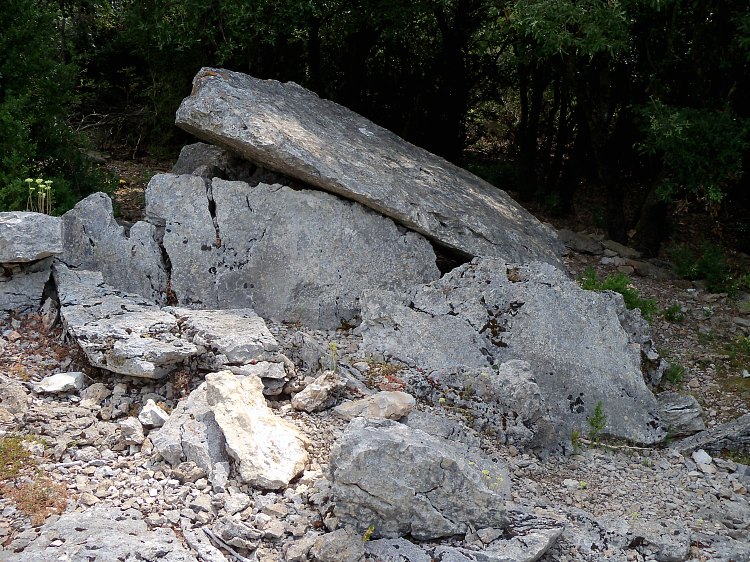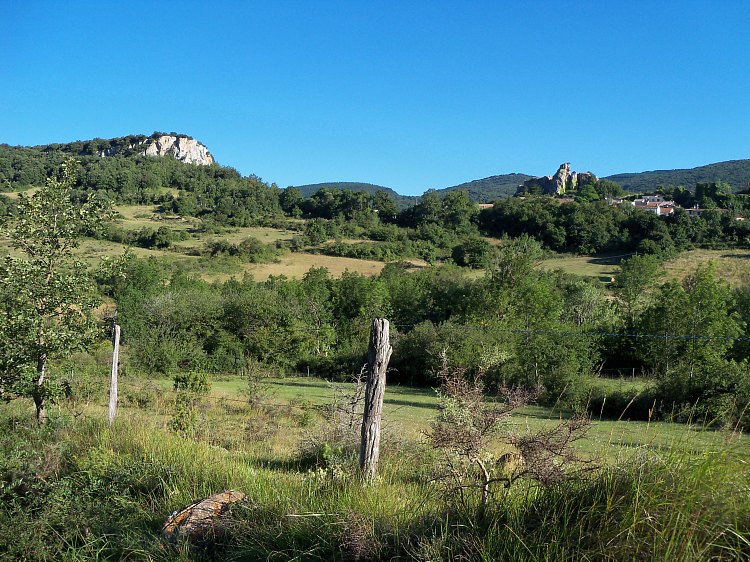Germain Sicard – doctor, wine estate owner, speleologue and archaeologist – has been an amiable companion throughout this summer. His first journey into ‘Les Corbières Sauvages’ was blighted by an easter blizzard, with no dolmens explored and little to report.
A second invitation was offered by ‘notre dévouée collègue Madame Landriq’, who had meanwhile discovered some ‘nouvelles instances’ – more dolmens for the 71 year-old enthusiast to explore. So on July 27th. 1922, he secured his bicycle in the guard’s van at Carcassonne station – ‘d’aller de nouveau dans cette si intéressante, si sauvage et si peu explorée région des Corbiéres.’

At 9.20 two trains pulled in to the station at St. Paul de Fenouillet – his and the train from Rivesaltes bringing the 22 year-old Philippe Héléna – ‘tous grands amateurs de préhistoire’. Then it was off on their ‘bécanes’ up the 12 kms. through the Gorges de Galamus to Cubières-sur-Cinoble, where they met M. and Mme. Landriq, and enjoyed ‘un excellent repas champêtre’.
The four then set off on their ‘machines’ up the road to Soulatge. The dolmen de l’Arco dal Pech is now marked on the IGN Serie Bleu map and is part of a walking trail – back then it was a steep trackless scramble up through trees and box-brush to the summit. Did Mme Landriq wear long skirts – or was she modern enough to sport cycling knickerbockers (‘rationals’)?
[ She will get a Page to herself, in due course – Les Dolmens Imaginaires de Mme. Landriq.]
It’s a stiff thirty minute walk up to the one, two or three dolmens above Cubiéres, and Sicard was not disappointed with the massive, but rather dislocated megalithic tomb at the top.
He and I were less impressed with the other two ‘dolmens’ thirty metres down the slope.
It looks to me more like a diaclase – a wide fissure in the bedrock. I have seen and read about diaclases used as tombs – particularly up at the nécropole de Bois Bas. They may have been used as sepulchres in times of population-stress, when the tribe’s numbers were being severely reduced through epidemics (living close to animals was convenient – but deadly to a group that had not developed any immunities.)
Les Landriq had, so they said, found a quantity of grave-goods at or ‘near’ all three ‘dolmens’. Germain Sicard was not about to pour cold water on their enthusiasm that day. His account, if read carefully, does allow room for conjecture.
The team that are responsible for the waymarked track to the l’Arco dal Pech dolmen at Cubiéres, must also have read Sicard’s ‘Deuxième Excursion’ and have cleared around the two other graves. But essentially it is ‘Le beau dolmen bien conservé’ that Sicard came to see, that merits its own Page – where more information and photos will be posted.
Meanwhile the four of them carried on to Camps, where they spent the night at the Schoolhouse. This visit we set up our tent at La Ferme at Camps, where we met an international crew – some of whom have been loyal to the place for 27 years.
This was just the start of a busy weekend of megalith-hunting for Germain and me. I consider myself fairly fit – but I was having trouble keeping up with his itinerary. The following morning Sicard set of at first light to reach a barely known ridge that he called ‘le plateau de Moufri’ (this might be one of his typos, and thus should be Monfri, which might relate to the ridge called Frigoula) high above les Gorges de Galamus. This promontary is largely unknown : it is variously called ‘Frigoula’ and ‘Les Remparts des Sarrazins’. This was Mme Landriq’s next surprise.She thought it might be a Bronze-age defensive settlement, and subsequent researchers have confirmed her findings.
I had set myself the task of following Germain and Philippe, step by step out of the village, as the sun rose. The landscape no longer looks like this, with cleared fields and man and animal persuing hard but productive work.
The story of Camps, and how it was almost abandoned, and how it was bought by one man, and how it was allowed to return to wilderness? Well – that’s all for another story in another blog.
The walk to the ‘enceinte fortifiée’ of les Remparts des Sarrazins is detailed on its own Page, to the right.
The glorious late July weather allowed me to enjoy a ‘déjeuner sur l’herbe’ as did Germain and Philippe and Les Landriq, not to mention the miller from le moulin de l’Agly who led them high up onto the giddying peaks above Les Gorges.
It’s impossible to show how many hundreds of metres above the Gorges this is. The video replays some of the alarm I felt. This is an extreme defensive position, replicated throughout the region, where Bronze Age tribes felt threatend by invasive forces – and it was probably not long held or needed. It feels very much like the hillfort above our village of Moux – random vestiges of a temporary position constructed rapidly in time of extreme fear and uncertainty.
Again : more info and photos on les Remparts des Sarrazins Page.
As I settled to my lunch, having descended from one of the more extreme places of the Bronze-Age peoples – I realised that Sicard was above all else, a writer. He collected people and experiences and he shared them. Another Natural Scientist might have fussed about the stones under his feet – but Germain, at ease upon his back having descended from this alarming place of safety, could recall these thoughts :
Mais il faut quitter ce merveilleux spectacle, et redescendre les sentiers que nous avons trouvés si ardus à la montée. Nous déjeunons dans la vallée de Riol, près de la source, et pendant que nous reposons mollement sur la pelouse, deux aéroplanes passent bruyamment sur nos têtes, faisant vibrer l’air de leurs ronflements sonores, et filant dans l’azur comme des vautours.Ainsi après avoir visité sur le plateau de Moufri les débuts de la civilisation, nous envoyons franchissant l’espace la merveilleuse évolution.
One small aeroplane passed overhead as I descended. I had fervently hoped that some jet or other piece of machinery would so time its arrival to allow me to mirror and echo and double Sicard’s experience. It did – and I recognised it as a tourist plane taking photos of what is now the bigger show in town : the ‘Cathar Castles’ – for which this region (for better or for worse) is now so well-known.
[NB This post is being copied in its entirety over on to the Page section: Sicard’s 2nd. Excursion.]
There is a Page on the Cubières dolmen or l’Arco dal Pech – to the right.









Leave a comment